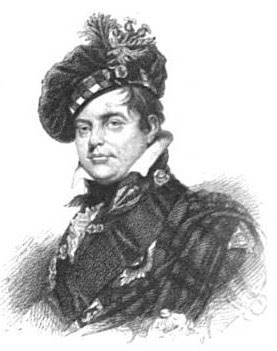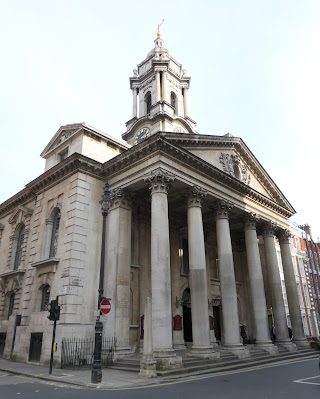 |
Augustus, Duke of Sussex
from A Biographical Memoir of Frederick,
Duke of York and Albany
by John Watkins (1827) |
Profile
Early years
Prince Augustus Frederick was born on 27 January 1773 at Buckingham House. He spent his early years at
Kew, sharing a house with his brothers
Ernest and
Adolphus. He was nominated a Knight of the Garter on 2 June 1786 and then travelled to the University of Göttingen to study.
1
Augustus was prevented from joining the army like his brothers because of ill health; he suffered badly from asthma. In later years, he habitually wore a black skull cap and was constantly worrying about his health. In 1832, he started to go blind, but underwent what was then a new and dangerous cataract operation which saved his sight.
Appearance and character
Augustus was over six foot three inches tall and had a handsome face like his brother
George IV. He was gifted musically with a particularly fine singing voice of which he was very proud.
I have the most wonderful voice that was ever heard – three octaves – and I do understand music.2
 |
The Freemasons' Hall, Great Queen Street
from The Microcosm of London volume 2 (1808-10) |
|
He had a genuine interest in the arts and science and amassed a huge library, a variety of singing birds and a large number of clocks. He also became involved with many charitable concerns. He became grand master of the Freemasons in 1811, was elected president of the Society of Arts in 1816 and was elected president of the Royal Society in 1830, though he resigned from the latter in 1838 because the presidential dinners were costing him too much money.
Romance in Rome
In 1792, Augustus spent the winter in Rome, as the warmer climate was better for his asthma. During this time, he met and fell in love with Lady Augusta Murray, a daughter of the Earl of Dunmore who was some years his senior. They were married on 4 April 1793 in a private ceremony without witnesses conducted by an English clergyman, the Reverend Gunn. The ceremony was repeated on 5 December at
St George’s Hanover Square, using the names Augustus Frederick and Augusta Murray.
 |
St George's Hanover Square (2015)
|
Illegal and unsuccessful
Under the Royal Marriages Act of 1772 Augustus needed the King's consent for his marriage to Augusta in order for it to be valid. As Lady Augusta was not of royal birth, that consent was not given, and the King had the marriage set aside in August 1794. The couple had two children, Augustus Frederick (1794) and Augusta Emma (1801), who took the surname d’Este.
They lived together in Berlin and then in London until 1801 when the couple separated. Later, Lady Augusta had to be restrained from using the title of Duchess of Sussex and she lost custody of the two children. From 1809 until her death in 1830, she was known as the Countess d’Ameland.
After
William IV became king, Augustus d’Este caused a scandal by trying to prove that his parents’ marriage was legitimate and claiming the right to inherit his father’s title.
On 27 November 1801, Augustus was made Duke of Sussex, Earl of Inverness and Baron Arklow and given a parliamentary allowance of £12,000, which he desperately needed.
Augustus was a devoted Whig and held very progressive political views in complete opposition to his father and later his brother George, supporting the
abolition of the slave trade, Catholic emancipation and political reform.
In 1830, when William IV became king, he made Augustus ranger of the royal parks.
Princess Charlotte
When
Princess Charlotte ran away to her mother at Connaught House in 1814 as a result of her father’s harsh treatment, it was to the Duke of Sussex that she looked for help. Advised that they had no legal right to resist the Princess being taken forcibly back to Carlton House, Augustus encouraged her to return to her father.
But the matter did not stop there. Augustus wrote to Lord Liverpool, the Prime Minister, demanding to see his niece and referring to her virtual imprisonment in her father’s house.
On 19 July 1814, Augustus took it one step further and addressed Lord Liverpool in public in the House of Lords, asking whether the Princess was allowed to see her friends, whether she was allowed “the free exercise of her pen”, whether she had personal liberty, whether she was to be allowed to go sea-bathing (which had been recommended for her health) and whether she was to be given an establishment of her own.
 |
Princess Charlotte of Wales
from La Belle Assemblée (1816) |
The address caused considerable embarrassment in the House; Lord Liverpool forbore to make any answer and the Lord Chancellor, Lord Eldon, took it upon himself to rebuke Augustus.
But the publicity had the desired effect; Princess Charlotte was soon seen riding in Windsor Park and in September, she was sent to
Weymouth for her health. However, it caused a further deterioration in the relationship between Augustus and his brother George.
A second illegal marriage
After the death of Lady Augusta in 1830, Augustus contracted a second illegal marriage. On 2 May 1831 he married Lady Buggin, the widowed daughter of the Earl of Arran, who became known as Lady Cecilia Underwood. In 1840, she was made Duchess of Inverness by Queen Victoria, who was very fond of Augustus, her favourite uncle.
Death
 |
Kensington Palace (2017)
|
The Duke of Sussex died on 21 April 1843 at
Kensington Palace from erysipelas, a bacterial infection of the skin sometimes known as St Anthony’s Fire. He was buried in the public cemetery at Kensal Green on 4 May 1843 and Lady Cecilia was later buried beside him.
 |
The grave of Augustus, Duke of Sussex,
in Kensal Green Cemetery, London (2015)
|
Rachel Knowles writes clean/Christian Regency era romance and historical non-fiction. She has been sharing her research on this blog since 2011. Rachel lives in the beautiful Georgian seaside town of Weymouth, Dorset, on the south coast of England, with her husband, Andrew.
Find out more about Rachel's books and sign up for her newsletter here.
If you have enjoyed this blog and want to encourage me and help me to keep making my research freely available, please buy me a virtual cup of coffee by clicking the button below.
Notes
(1) From Ernest Augustus (1771-1851), Oxford Dictionary of National Biography by Alan Palmer (2004)
(2) From Royal Dukes by Roger Fulford (1933, revised 1973)
Sources used include:
Ackermann, Rudolph and Pyne, William Henry, The Microcosm of London or London in miniature Volume 2 (Rudolph Ackermann 1808-1810, reprinted 1904)
Fulford, Roger, Royal Dukes (1933, revised 1973)
Henderson, TF and revised by Van der Kiste, John, Augustus Frederick, Prince, Duke of Sussex (1773-1843) Oxford Dictionary of National Biography (Oxford University Press, 2004; online edn Jan 2008, accessed 23 Mar 2013)
Hibbert, Christopher, George IV (1972, Longmans, 1973, Allen Lane, London)
Huish, Robert, Memoirs of her late royal highness Charlotte Augusta (1818)
Palmer, Alan, Ernest Augustus (1771-1851), Oxford Dictionary of National Biography, (Oxford University Press, 2004, online edn, May 2009, accessed 23 Mar 2013)
Watkins, John, A Biographical Memoir of Frederick, Duke of York and Albany (1827, London)
All photographs © RegencyHistory.net








Very interesting. Knew very little about Augustus before. Thank you.
ReplyDeleteI'm glad that you enjoyed the post, Jan. I admire the fact that he stuck to his Whig beliefs rather than giving them up like his eldest brothers did.
DeleteAnother decent Royal, it's good to see that they were not all bad, thank you for telling us about these interesting lesser known royals.
ReplyDelete( I'm glad to be up and about again enjoying your posts; I have some catching up to do.
:)
Augustus really suffered from the Royal Marriages Act. Although not royal, Augusta could trace her ancestry back to royal blood and it seems ridiculous that her birth was unacceptable. Glad to have you back commenting!
DeleteWas interested in Augustus as he was the Godfather of Augustus Sussex Milbank of Thorpe Perrow in Yorkshire. Many thanks for the info.
ReplyDeleteGlad to be of help. I had not heard of Augustus Sussex Milbank before. I see that he was the Deputy Lieutenant of Durham and Justice of the Peace of North Riding. Do you know what his family's connection with the Duke was?
DeleteGreat help understanding Emma's background to her faith and patronage of the Ramsgate Holy Trinity ' HIgh ' church in Bellevue Rd, plus it's pro-catholic stained glass windows and devotional aspects to St Mary and her famous role in Thanet Christian life for centuries.
ReplyDeleteI am curious about the Duke of Sussex wearing a black cap, which is apparent in the painting of Queen Victoria's marriage. Was this just an affectation or was it a formal part of ducal robes?
ReplyDeleteThank you for pointing my query to this article. In view of his erysipelas, it seems possible he wore his black skull cap to cover a skin condition on his (presumed) bald patch.
DeleteInteresting. Thanks for posting.
ReplyDeleteperhaps I am missing something, but would not he be first in line to the throne at the death of his father rather than Victoria?
ReplyDeleteNo. The succession order was eldest son; if already deceased, eldest son of eldest son; if none alive, other sons and then daughters in age order. If no one in the eldest son's line is alive to succeed to the crown, it would go to the next sons, in age order, and the same rules would then apply. When George III died, he was succeeded by his eldest son George IV. George IV's only child Charlotte and the next brother in line Frederick, Duke of York (who had no legitimate children), both died before George IV, so the crown went to the next brother William IV. William had no legitimate children so the crown would have gone to the next brother, Edward Duke of Kent, but as he had predeceased William, the crown went to Edward's only child Victoria (there being no sons to inherit the crown). Hope that makes sense.
DeleteThen after Victoria there was The Duke of Cumberland who inherited the throne of Hanover since that kingdom went
ReplyDeleteby Salic law which excluded females thus prohibiting Victoria from inheriting. The Duke of Sussex came after that.